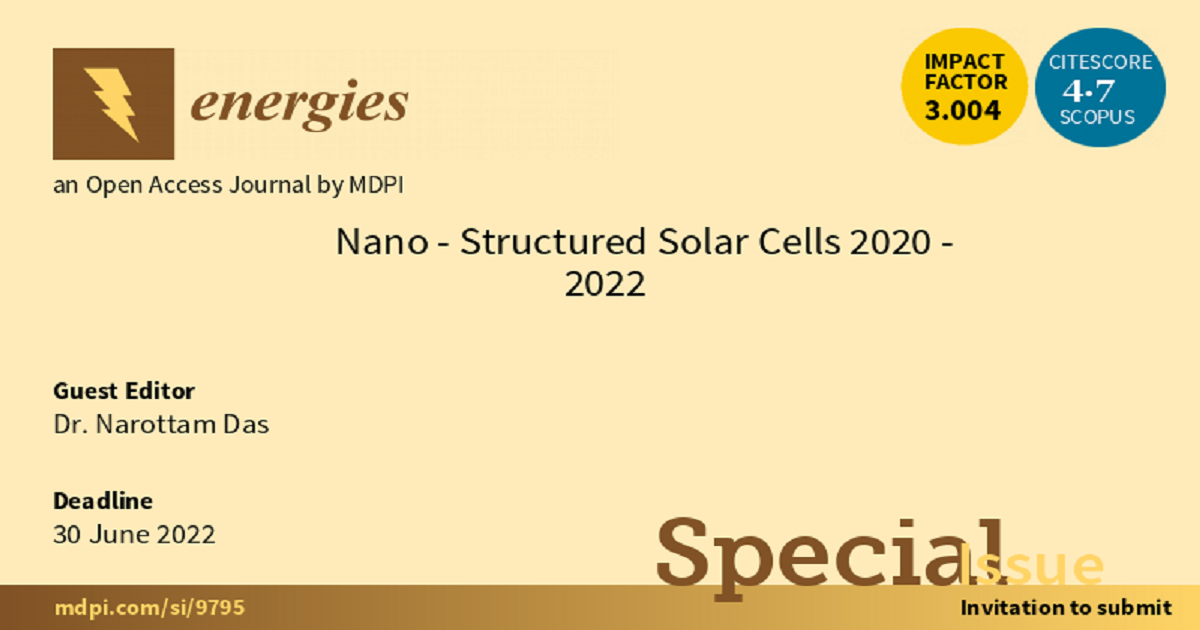Nano-Structured Solar Cells 2020-2022
A special issue of Energies (ISSN 1996-1073). This special issue belongs to the section "D: Energy Storage and Application".
Deadline for manuscript submissions: closed (30 June 2022) | Viewed by 40642

Special Issue Editor
Interests: photovoltaic (PV) cells; nano-structured solar cells; plasmonics solar cells; thin film solar cells; nanotechnology; semiconductor devices; solar cells and PV systems; renewable energy technology; smart grid systems; IEC 61850 for substation automation system
Special Issues, Collections and Topics in MDPI journals
Special Issue Information
Dear Colleagues,
Nano-structured or thin-film solar cells are an exciting and promising approach for renewable (i.e., photovoltaics (PV)) energy generation and it offers variety of choices in terms of device design, modelling, fabrication, and analysis for the improvement of conversion efficiency. Nano-structured or thin-film technologies have a great potential to reduce the cost by eliminating wafer slicing and reducing the material consumption by a factor of more than ten. Existing progress in solar or PV systems is causing the demand for silicon wafers to outstrip the capacity to supply, creating a market entry opportunity for a number of competing thin-film technologies, as well as nano-structured solar cells. An absorber layer can be deposited at the required thickness, greatly reducing wastage provided source material utilisation is a very good approach. There are variety of substrates, such as insulators or metals, are used for the deposition of different layers using different deposition techniques. This versatility allows tailoring and engineering of the layers in order to improve the device performance and to improve the conversion efficiency of nano-structured solar or PV cells. For large-area devices required for realistic applications, thin-film device fabrication becomes complex and requires proper control over the entire process. Hence, proper understanding of thin-film deposition processes can assist in achieving high conversion efficiency for different nano-structured or PV cells. Research and development is a new, exotic and simple materials and devices, and innovative, but simple manufacturing processes need to be pursued in a focussed manner. Therefore, we welcome research and review papers (both theoretical and experimental) for the development of high conversion efficiency thin film solar or nano-structured solar or PV cells and related areas. This Special Issue will cover the following, but not limited to this list:
- Nano-structured solar or PV cells
- Nano-structured solar cells for high conversion efficiency
- Thin film solar cells
- Plasmonics solar cells
- PV array systems
- Design and modeling of plasmonics solar cells
- Muli-junction solar cells
- Solar cells and PV systems
- Nanotechnology for improvement of solar cell conversion efficiency
- Semiconductor devices for the development of thin film solar cells
- Renewable energy technologies for the development of high effocienvcy solar cells
We welcome papers on nano-structred solar cells, thin-film solar cells, semiconductor devices, PV systems, plasmoniuc solar cells, as well as cutting-edge examples or models from industrial practice that can be used to encourage sustainable development and performance of thin film solar cells for the improvement of conversion efficiency.
Dr. Narottam Das, SMIEEE
Guest Editors
Manuscript Submission Information
Manuscripts should be submitted online at www.mdpi.com by registering and logging in to this website. Once you are registered, click here to go to the submission form. Manuscripts can be submitted until the deadline. All submissions that pass pre-check are peer-reviewed. Accepted papers will be published continuously in the journal (as soon as accepted) and will be listed together on the special issue website. Research articles, review articles as well as short communications are invited. For planned papers, a title and short abstract (about 100 words) can be sent to the Editorial Office for announcement on this website.
Submitted manuscripts should not have been published previously, nor be under consideration for publication elsewhere (except conference proceedings papers). All manuscripts are thoroughly refereed through a single-blind peer-review process. A guide for authors and other relevant information for submission of manuscripts is available on the Instructions for Authors page. Energies is an international peer-reviewed open access semimonthly journal published by MDPI.
Please visit the Instructions for Authors page before submitting a manuscript. The Article Processing Charge (APC) for publication in this open access journal is 2600 CHF (Swiss Francs). Submitted papers should be well formatted and use good English. Authors may use MDPI's English editing service prior to publication or during author revisions.
Keywords
- thin film solar cells
- nano-structured solar cells
- PV array systems modelling
- multi-junction solar cells
- development of thin film solar technology
- design and modeling of solar cells
- materials structure and layers for solar cells
- light trapping in solar cells
- plasmonic nanostructured for solar cells
- PV systems for high conversion efficiency
- nanotechnology for the development of solar cells
- semiconductors for thin film solar cells
- renewable energy technologies
- high efficiency solar cells





